This website uses cookies
This website uses cookies to enable it to function properly and to analyse how the website is used. Please click 'Close' to accept and continue using the website.


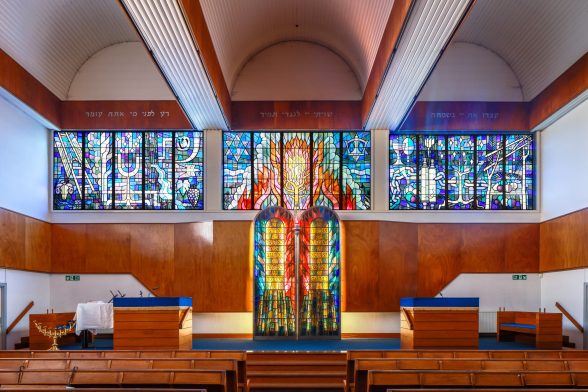
Image: John East
C20 Society has submitted a listing application for Brighton and Hove Reform Synagogue, in a bid to save the modernist building and its extraordinary stained glass windows from proposed demolition. The site is unique in the UK in that it serves as both a Holocaust memorial and a place of worship, with its luminescent east facing windows described by Art Historian Dr Alison Smith as “one of the great religious artworks of the 20th century”.
Designed by architects Derek Sharp Associates and built between 1967-68, the synagogue is currently threatened by plans from a local developer that would see the historic building make way for a block of 18 residential flats, with a smaller replacement synagogue apologetically placed elsewhere on the site.
C20 first applied to list the synagogue in 2017 in response to prior approval being granted for demolition, but Historic England disappointingly recommended against listing in 2018. The previously consented development scheme subsequently fell-through and important new evidence has since emerged regarding the rarity and significance of the stained-glass windows, demanding the building now be re-appraised for listing.
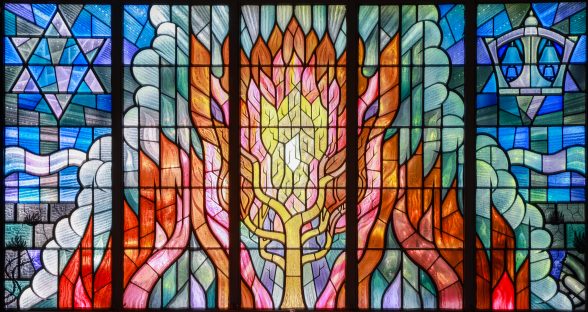
Image: John East
Holocaust Memorial
The central features of the synagogue are its Ark and the 40ft long stained-glass windows, designed by artist John Petts and depicting scenes from the Revelation.
The Ark is enclosed by two eleven-feet-high stained-glass doors, which can be drawn sideways to access the sacred Torah scrolls. The main windows are composed of some 1,800 individual pieces of coloured glass, with the central panel showing the Burning Bush in fiery reds and yellows, flanked by side panels in blues, greens and greys, with Symbols referencing the key Jewish festivals Pesach, Shavuot, Succoth and Hanukkah. The elements binding them all together are broken barbed wire, and the chain link broken by a sapling – representing the oppression of the Jewish people through history, and the atrocities of the Holocaust.
Historians have also drawn comparison to Picasso’s seminal work, Guernica (1937), and the way both artworks articulate the personal, emotional and historical dimensions of modern warfare and the atrocities it has engendered. The windows have been identified by the Imperial War Museum as a Holocaust memorial and are the most significant example of Petts work in UK, yet are not as widely recognised as they should be. It was long felt that they should not be advertised lest they fall victim to anti-Semitic attack (as indeed they did during the 1970s), and initial plans for an external inscription were abandoned. The foundation stone in the foyer reads: ‘In dedication to the glory of God and in memory of the 6 million Jews who perished in the concentration camps during the 1939-1945 World War./ In honour of the dead as a warning to the living’.
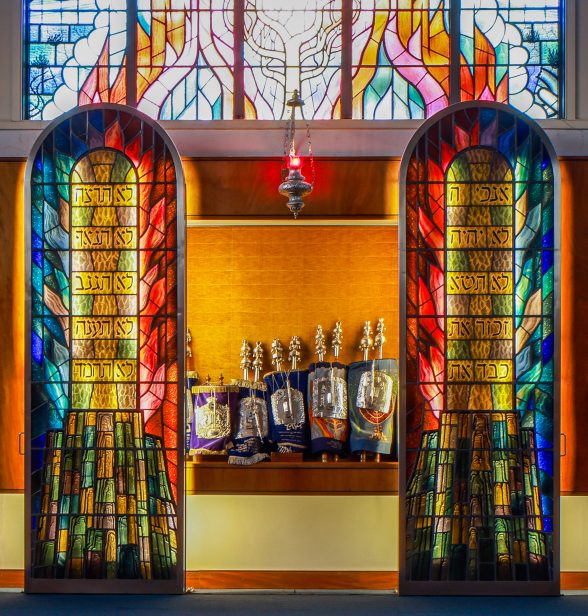
Image: John East
John Petts and the Alabama ‘Wales Window’
Such was the ambition for the new Synagogue, Rabbi Erwin Rosenblum (a Holocaust survivor himself) initially approached artist Marc Chagall to undertake the commission for the windows. Instead John Petts was chosen, given his international standing at the time as the creator of the Wales Window for the 16th St Baptist Church in Birmingham, Alabama.
On the 15th of September 1963, the Ku Klux Klan planted a bomb at the 16th Street Baptist Church, Birmingham, Alabama, that killed four black girls attending Sunday school and destroyed parts of the church. News of the bombing reached artist John Petts in Llansteffan, Carmarthenshire, whereupon he quickly offered his services to create and install a replacement window. A front-page campaign in the Welsh press helped raise funds for the venture, and within just two years Petts had delivered his gift from the people of Wales.
The church has since become an important historical landmark, attracting thousands of visitors each year, and the window is regarded as one of the key icons of the American Civil Rights Movement – a powerful protest against intolerance and injustice. It’s the most celebrated international example of Petts work and is believed to be among the first depictions of Christ as a Black man in this medium.
The Brighton windows invite clear comparison to the Alabama window, in terms of their deep colour and sensitive iconographic scheme, with each element conveying a particular religious and wider humanitarian message.
John Petts (1914-1991) was born in London though spent his working life in Wales, abandoning his studies at the Royal Academy in 1935, to move to Snowdonia with his wife, the artist Brenda Chamberlain. Petts began his creative practice as a wood engraver, though from 1961 until his death in 1991 he was engaged as a stained glass designer, primarily of memorial windows, the majority of which are located in Dyfed, Glamorgan and Gwent.
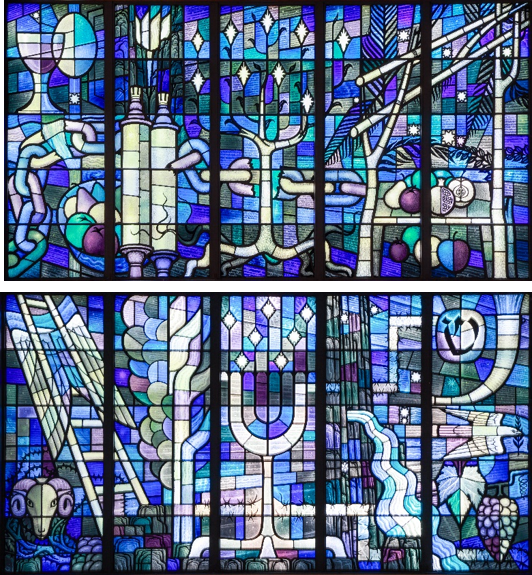
Image: John East
Community and modernity
With its triple barrel vaulted roof, scalloped perforated brick screens and slender semi-circular concrete canopy, the Synagogue is a distinctively modern yet discreet presence in leafy residential streets of Brighton and Hove. The four storey building stands at the corner of Palmeira Avenue and Eaton Road, neighboring the Sussex County Cricket Ground.
Internally, its key spaces are remarkably well preserved, with the triple vault of the prayer hall recalling the interior of the 17th-century Portuguese Synagogue of Amsterdam, and able to accommodate up to 630 worshippers.
The construction was a community endeavour, with every member of the synagogue asked to donate towards the new building and contribute “even just a brick”. Records show one child donating £1 of pocket money in 1966.
The congregation at the time was composed largely of tradespeople, who would have had the collective expertise to obtain the best materials that money could buy, as can be seen in the surviving timber furniture and fittings.
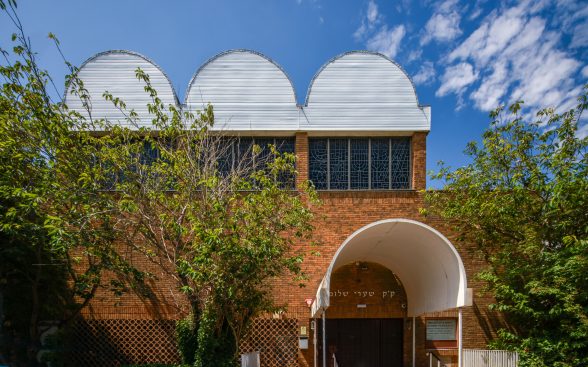
Image: John East
Post-war Jewish heritage
Historic England have acknowledged that Jewish heritage is currently under-represented on the national register, with the Synagogue at Carmel College in South Oxfordshire (1963) the only listed post-war synagogue in England. Approximately 150 post-war churches are nationally listed.
There are thought to be approximately 50 listed Second World War Memorials in England, of which only one is dedicated to the victims of the Holocaust – the ‘Memorial sculpture group’ in Gladstone Park, Dollis Hill in London (c. 1967-68).
The Society strongly believes that the Brighton & Hove Reform Synagogue has clear historic significance, architectural merit and communal value, and has recommended the building for inclusion on the National Heritage List for England at Grade II.
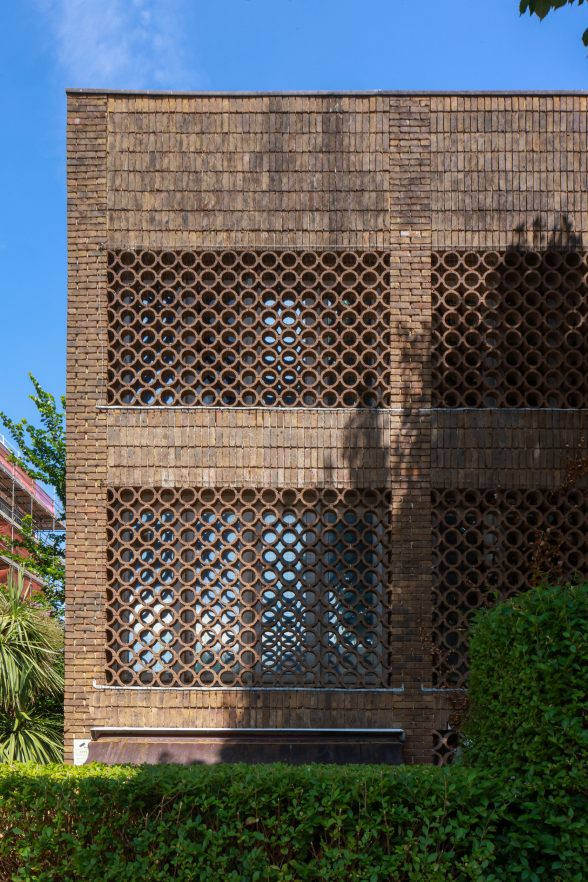
Image: John East
Coco Whittaker, Senior Caseworker at C20 Society said:
“The Brighton and Hove Synagogue has outstanding cultural significance: its post-war architecture and artwork is exceptional, and it has major communal value as a Holocaust memorial and as a social and spiritual centre. The demolition of this remarkable and important building would represent an extraordinary loss to the nation – it must be prevented.”
Art historian Dr Alison Smith said:
“Brighton and Hove Reform Synagogue is unique in that it serves as a memorial as well as a place of worship, and as such it was intended to last for generations. The John Petts windows stand as one of the great religious works of art of the 20th century, comparable to John Piper’s stained glass in Coventry Cathedral, in encapsulating the suffering and enduring spirit of Jewish people in the face of the horrors unleashed during the Holocaust. I can think of no comparable Holocaust memorial of this scale and quality in the UK.”

Become a C20 member today and help save our modern design heritage.